 From Proceedings of the Athanasius Kircher Society comes this wonder, a rotary desk that allows a person to keep up with multiple books at once. Designed in 1588 by Italian engineer Agostino Ramelli, "with this sort of machine a man can see and read a great quantity of books, without moving his place: besides, it has this fine convenience, which is, of occupying a little space in the place where it is set."
From Proceedings of the Athanasius Kircher Society comes this wonder, a rotary desk that allows a person to keep up with multiple books at once. Designed in 1588 by Italian engineer Agostino Ramelli, "with this sort of machine a man can see and read a great quantity of books, without moving his place: besides, it has this fine convenience, which is, of occupying a little space in the place where it is set."
11.30.2006
Rotary Reader
 From Proceedings of the Athanasius Kircher Society comes this wonder, a rotary desk that allows a person to keep up with multiple books at once. Designed in 1588 by Italian engineer Agostino Ramelli, "with this sort of machine a man can see and read a great quantity of books, without moving his place: besides, it has this fine convenience, which is, of occupying a little space in the place where it is set."
From Proceedings of the Athanasius Kircher Society comes this wonder, a rotary desk that allows a person to keep up with multiple books at once. Designed in 1588 by Italian engineer Agostino Ramelli, "with this sort of machine a man can see and read a great quantity of books, without moving his place: besides, it has this fine convenience, which is, of occupying a little space in the place where it is set."
11.28.2006
Build-a-Bert
 Using a computer-modeled wireframe head from a previous project, artist Bert Simons "cloned" himself, making a cut-out replica of his noggin to keep around the house. He even provides a pdf so you can build your own. Final version above, beta version below.
Using a computer-modeled wireframe head from a previous project, artist Bert Simons "cloned" himself, making a cut-out replica of his noggin to keep around the house. He even provides a pdf so you can build your own. Final version above, beta version below. Via PlaceboKatz.
Via PlaceboKatz.
Eyeteeth Elsewhere
FYI: the interview I did with NEED co-founder and editor in chief Stephanie Kinnunen is now online at Worldchanging, and a piece following a rumored newsroom shakeup at the cash-strapped St. Paul Pioneer Press is at Minnesota Monitor.
Conservation.
Enough
 Nice concept for a Denver water conservation campaign. Could apply to just about anything--oil, electricity, food...
Nice concept for a Denver water conservation campaign. Could apply to just about anything--oil, electricity, food...
11.27.2006
Filling a NEED: "LIFE for a new generation"
 Flip through the premiere issue of NEED, a new magazine produced in northeast Minneapolis, and you'll be confronted: with horrifying before-and-after photos of Marthaline, a Liberian woman, whose tumor growing in her mouth the past three years was beginning to suffocate her, prompting her to buy poison to end her suffering. With a quote by a Minnesotan named Patrick who "got lost" looking for a bathroom while passing through New Orleans four months ago and ended up staying there to help rebuild the city. With the faces of young girls--their eyes blurred out to protect their identity--who'd been rescued from the sex trade in Cambodia, bursting into laughter over cans of Sprite.
Flip through the premiere issue of NEED, a new magazine produced in northeast Minneapolis, and you'll be confronted: with horrifying before-and-after photos of Marthaline, a Liberian woman, whose tumor growing in her mouth the past three years was beginning to suffocate her, prompting her to buy poison to end her suffering. With a quote by a Minnesotan named Patrick who "got lost" looking for a bathroom while passing through New Orleans four months ago and ended up staying there to help rebuild the city. With the faces of young girls--their eyes blurred out to protect their identity--who'd been rescued from the sex trade in Cambodia, bursting into laughter over cans of Sprite.But the confrontation isn't about guilt or shock, but hope: you can't help but be moved by how much people are pitching in to help those in need--and how little it takes to remove a benign tumor, pick up a hammer, or provide supplies for groups giving girls hope after being sold into sexual slavery.
The brainchild of Kelly and Stephanie Kinnunen, NEED launches today with a print run of 25,000 copies and the simple mission of giving exposure to humanitarian aid organizations that do good work. Beautifully designed and printed, perfect-bound, and filled with full-bleed photographs by photojournalists including Steve McCurry, the publication avoids the political, instead putting its energy toward connecting potential donors and volunteers for humanitarian causes with the beneficiaries of that work.
 The inaugural issue begins with an introduction to Timon Bondo, a 70-year old Kenyan man who lives in Golden Valley and has almost single-handedly raised funds to build two schools and a healthcare center in his AIDS-ravaged village Rabondo. His successes have come mainly through cold-calling--and despite one major obstacle: he's blind. But Stephanie Kunninen says NEED didn't feature Bondo's work simply to raise awareness of Rabondo or Bondo's work, but to also highlight how the man sets about helping his village.
The inaugural issue begins with an introduction to Timon Bondo, a 70-year old Kenyan man who lives in Golden Valley and has almost single-handedly raised funds to build two schools and a healthcare center in his AIDS-ravaged village Rabondo. His successes have come mainly through cold-calling--and despite one major obstacle: he's blind. But Stephanie Kunninen says NEED didn't feature Bondo's work simply to raise awareness of Rabondo or Bondo's work, but to also highlight how the man sets about helping his village."If you want to help a little girl with a school uniform, he won’t let you buy a school uniform. You buy fabric; then he utilizes one of the local seamstresses and pays her to sew the uniform for the child," she says. "One widow is taking care of 12 of her grandchildren because her husband and children have died from AIDS. So she makes bricks in her front yard while the children go to school, then when Timon does a building project, he buys the bricks from her instead of from the wealthy businessman in Nairobi."
The issue also features an array of aid programs around the world, including literacy programs in Afghanistan (McCurry's ImagineAsia among them); the floating MercyShips hospital that removed Marthaline's tumor (and those of many others); and Right to Play, a group founded by Olympic speedskating gold medalist Joey Cheek that uses sports as a platform to teach kids around the world about healthy living. Issue 2 will look at child soldiers in northern Uganda, Colombia's population of "internally displaced people" (the country has the world's second largest population of IDPs), and Wings of Hope, to name a few.
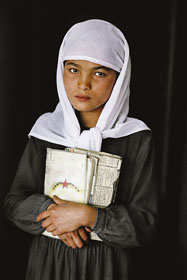 The magazine, which sent out its first 2,500 issues over the past weeks, is a hit with philanthropists and nonprofits, says Kinnunen. She reports that a big supporter of the UN's Refugee Committee, the UNHCR, ordered 100 subscriptions for friends and family, plus bought up 1,350 issues to send to the organization's top monthly donors. But the Kinnunens are surprised at the buzz beyond this insider community.
The magazine, which sent out its first 2,500 issues over the past weeks, is a hit with philanthropists and nonprofits, says Kinnunen. She reports that a big supporter of the UN's Refugee Committee, the UNHCR, ordered 100 subscriptions for friends and family, plus bought up 1,350 issues to send to the organization's top monthly donors. But the Kinnunens are surprised at the buzz beyond this insider community."We’ve received a subscription from an inmate at Moose Lake Prison, a 16-year old high school student in Prior Lake, Minnesota, an order of nuns in north Minneapolis, a woman in Virginia who owns a tattoo parlor," she says. "NEED's demographic has become all across the board. Even my mother’s friends are clamoring for this."
But the early success has also earned other key endorsements: President Jimmy Carter agreed to an interview in the debut issue, and an impressive array of celebrated photojournalists have signed on. More remarkable is that group's assessment.
"We hear over and over and over again from photographers, 'This is the new LIFE Magazine for our generation of photojournalists.' That’s such a huge compliment to us," she says. "How could we ever—I mean, we’re six people in a warehouse office in Northeast Minneapolis! To hear this could be the next LIFE magazine is such an honor and shock, almost."
We hear over and over and over again,
"This is the new LIFE Magazine
for our generation of photojournalists."
"This is the new LIFE Magazine
for our generation of photojournalists."
The magazine is also compared to another famous publication, one heralded for its edgy design and unflinching portrayal of graphic suffering in the world--Oliviero Toscani's COLORS. Kinnunen says wherever she and her husband have lived--most recently, they lived in Finland, where Kelly taught at a university and Stephanie taught business English--they sought out each issue of the publication. "We love the imagery of COLORS Kinnunen says wherever she and her husband have lived--most recently, they lived in Finland, where Kelly taught at a university and Stephanie taught business English--they sought out each issue of the publication. "We love the imagery of COLORS. We love the storytelling of colors, but again, we're inspired by contact. There's no way for us to become involved with the something. Thgat's the one thing we didn't like about COLORS."
 The production value of NEED, however, is on par with COLORS', using full-color photos, with text as backup, to tell its stories. And NEED's art-magazine price tag of $9 seems to reflect that quality. But the Kinnunen's, who funded the magazine entirely with their own savings and their now-maxed-out credit cards, believe the cause is worth the price tag. "We have a 19.5% ad ratio to content, when we’re full. So if we’re full of ads, there’s 19.5% and you’re getting the highest quality printing, photography, and uninterrupted stories for nine dollars—if that’s to value of you, you see $9 as quite inexpensive. If you see $9 as too expensive, we do have a great website where people can get involved," Kinnunen says.
The production value of NEED, however, is on par with COLORS', using full-color photos, with text as backup, to tell its stories. And NEED's art-magazine price tag of $9 seems to reflect that quality. But the Kinnunen's, who funded the magazine entirely with their own savings and their now-maxed-out credit cards, believe the cause is worth the price tag. "We have a 19.5% ad ratio to content, when we’re full. So if we’re full of ads, there’s 19.5% and you’re getting the highest quality printing, photography, and uninterrupted stories for nine dollars—if that’s to value of you, you see $9 as quite inexpensive. If you see $9 as too expensive, we do have a great website where people can get involved," Kinnunen says.But, more convincing is her argument of the need for such production values. On one hand, she and Kelly were inspired by the director of a refugee shelter Kelly volunteered for in Greece years ago; he refused a load of bread from a baker who "was trying to pass off day-old bread" on the shelter residents, retorting, "Just because these people are poor doesn’t mean they don’t deserve the very best."
"So often aid organizations have such small budgets, and they don’t want to sacrifice their budgets that are going to directly helping people in need to promoting their work and connecting potential supporters to their work," she adds. "We wanted to help in that way. How do we help the people who are helping the people on the ground and showing the people in need in a dignified way?"
Photos (top to bottom): Cover of NEED, an Afghani boy in school, by Steve McCurry; Timon Bondo by Justin Grierson; Afghani Girl by Steve McCurry; a volunteer with a homeowner in New Orleans, by Leslie Spurlock.
More on NEED: Read my interview with Kinnunen at Worldchanging, plus Brian Lambert's "Disaster Glam."
11.22.2006
Rest in peace, Sister Rita
As Doug Grow recounts, she told the judge who sentenced her: "Your honor, I'm 70 years old today and I've never been in prison and I'm scared. I tell you, when decent people get put in jail for six months for peaceful demonstration, I'm more scared of what's going on in our country than I am of going to prison."
So long...
Thomas Hirschhorn's unbuilt book
11.21.2006
Rethinking the brand: Hank Willis Thomas
 Hank Willis Thomas addresses commodification in his art--specifically, a link between the commodification of African men in the slave trade and the use of black bodies to hawk goods from credit cards to Nikes today. His work deals explicitly with branding, from the product logos plastered on athletes and rap stars to the markings that identified slaves.
Hank Willis Thomas addresses commodification in his art--specifically, a link between the commodification of African men in the slave trade and the use of black bodies to hawk goods from credit cards to Nikes today. His work deals explicitly with branding, from the product logos plastered on athletes and rap stars to the markings that identified slaves. But there also seems to be another take on "consumerism"--how capitalism eats up and spits out African Americans, and many of the rest of us as well. His appropriation of the Absolut Vodka ad, in which a slave ship floorplan forms the iconic bottle outline, suggests that our appetites have a price. Similarly, his piece Priceless #1 could be seen as a quick riff on a popular ad--and exploitative of the pictured family--until you hear the backstory.
But there also seems to be another take on "consumerism"--how capitalism eats up and spits out African Americans, and many of the rest of us as well. His appropriation of the Absolut Vodka ad, in which a slave ship floorplan forms the iconic bottle outline, suggests that our appetites have a price. Similarly, his piece Priceless #1 could be seen as a quick riff on a popular ad--and exploitative of the pictured family--until you hear the backstory.Thomas says:
I think that the irony of the ideal of the black male body is interesting…it is fetishized and adored in advertising but in reality black men are in many ways the most feared and hated bodies of the 21st Century. The majority of this work comes out of the experience of losing my cousin Songha Thomas Willis – he was killed because he was with someone who was wearing a gold chain. It is this idea – that someone could be killed over a tiny commodity. In NYC in the 1980s, people were killed over sneakers and backpacks. Songha was someone who survived DC when it was the murder capital of the country and then came home to Philly and was killed over a commodity. I want to question what makes these commodities so precious that they are worth defining and more importantly taking another person’s life?
Update: See Thomas' work here. Tyler Green offers his thoughts on Priceless #1 here.
11.20.2006
YouTube: The Allens
Steve Allen interviews Jack Kerouac (late 1960s):
Woody Allen interviews Billy Graham (1959):
Woody Allen interviews Billy Graham (1959):
All-American City: Pahrump, Nevada!
 Pahrump, Nevada is an exceedingly patriotic place: last week its town board made English its official language and, by a 3-to-2 vote, tossed aside Constitutionally-guaranteed rights to free expression to make it illegal to fly a foreign flag in town limits. To beef up their patriotic cred, I expect Pahrump--located 50 miles west of Las Vegas and 60 miles east of Death Valley--will be following suit by making a few updates to their website--and municipality's name--to reflect their motherland-loving attitude.
Pahrump, Nevada is an exceedingly patriotic place: last week its town board made English its official language and, by a 3-to-2 vote, tossed aside Constitutionally-guaranteed rights to free expression to make it illegal to fly a foreign flag in town limits. To beef up their patriotic cred, I expect Pahrump--located 50 miles west of Las Vegas and 60 miles east of Death Valley--will be following suit by making a few updates to their website--and municipality's name--to reflect their motherland-loving attitude. First off, "Pahrump" itself is a native American word. The town, originally a Shoshone settlement, takes its moniker from that tribe's word for "water rock"--Pah-Rimpi--which refers to the area's abundant artisan wells. While not foreign, it suggests a culture other than the mainstream, European-descended colonists of this land. Might want to revise that.
First off, "Pahrump" itself is a native American word. The town, originally a Shoshone settlement, takes its moniker from that tribe's word for "water rock"--Pah-Rimpi--which refers to the area's abundant artisan wells. While not foreign, it suggests a culture other than the mainstream, European-descended colonists of this land. Might want to revise that.Second, let's go to Pahrump's official "image gallery." The photo of a cowboy wielding a lariat (above) has got to go: "lasso" derives from the Spanish word for "snare"; "lariat" is from the Spanish for "rope." (The bucking bronco riders and rodeo cowboys are also in engaging in activities named by Spaniards and still used by the Latin Americans residents who share their language.)
The Pahrump Police Department had better stop using taxpayer funds to purchase and train foreign-named German Shepherds, a breed perfected by a Berlin-based veterinarian, Capt. Max von Stephanitz.
 This image of a guy barbecuing? Nix it. Barbecue comes from the Spanish word barbacoa, and is thought to go back to the West Indian Arawak people and their "method of erecting a frame of wooden sticks over a fire in order to dry meat."
This image of a guy barbecuing? Nix it. Barbecue comes from the Spanish word barbacoa, and is thought to go back to the West Indian Arawak people and their "method of erecting a frame of wooden sticks over a fire in order to dry meat."And this fellow had better stop wearing the Shriner's fez, a hat named after a Moroccan town; it was once part of the Turkish army's uniform before Mustafah Kemal banned it. Worn by some Muslim men, the fez "was chosen [as the Shriner symbol] as part of the Shrine's Arabic (Near East) theme." Pahrump's Shriner's might want to switch to paper hats constructed from... USA Today.

Pahrump's toga-wearing Greeks should, by town board decree, be directed to wear made-in-America dungarees, and the darling Pahrumpian below should remove her ten-gallon hat--if that's indeed what it is--because the term's got "foreign" written all over it:
 Ten-gallon hat" is the result of a linguistic mix-up. "Galón" is the Spanish word for "braid." Some vaqueros wore as many as ten braided hatbands on their sombreros, and those were called "ten galón hats." English speakers heard gallon. Real cowboy hats came to Texas from the Spanish via Mexico (unless you want to go all the way back to Genghis Khan and the Mongolian horsemen, who apparently wore something similar).
Ten-gallon hat" is the result of a linguistic mix-up. "Galón" is the Spanish word for "braid." Some vaqueros wore as many as ten braided hatbands on their sombreros, and those were called "ten galón hats." English speakers heard gallon. Real cowboy hats came to Texas from the Spanish via Mexico (unless you want to go all the way back to Genghis Khan and the Mongolian horsemen, who apparently wore something similar).If you'd like to make these sensible suggestions to the Pahrump town board, you can find their contact info here. (Board Chairman Richard Billman and member Laurayne Murray voted in opposition to the English-only decree.)
Cook Report: Coleman among Senate's "most vulnerable"
 Speculation about the 2008 Senate race is already heating up, with pundits making guesses about the seat once occupied by Paul Wellstone and now filled by Norm Coleman. Both sides of the aisle seem heartened by the mid-term results: Wizbang Politics opines that “Tim Pawlenty beat back the Democratic tide here, and Norm Coleman should do the same in 2008,” while potential Democratic candidates like R.T. Rybak and Betty McCollum, apparently emboldened by Amy Klobuchar’s "smashing victory" over Mark Kennedy (in University of Minnesota political scientist Larry Jacobs' words), seem poised to add their names to Al Frankens’ on the likely-to-run list. But one highly influential pundit makes a dire prediction for Coleman: Charlie Cook of The Cook Political Report, lists Coleman as one of two of the Senate’s “most vulnerable incumbents” (the other is Louisiana Democrat Mary Landrieu).
Speculation about the 2008 Senate race is already heating up, with pundits making guesses about the seat once occupied by Paul Wellstone and now filled by Norm Coleman. Both sides of the aisle seem heartened by the mid-term results: Wizbang Politics opines that “Tim Pawlenty beat back the Democratic tide here, and Norm Coleman should do the same in 2008,” while potential Democratic candidates like R.T. Rybak and Betty McCollum, apparently emboldened by Amy Klobuchar’s "smashing victory" over Mark Kennedy (in University of Minnesota political scientist Larry Jacobs' words), seem poised to add their names to Al Frankens’ on the likely-to-run list. But one highly influential pundit makes a dire prediction for Coleman: Charlie Cook of The Cook Political Report, lists Coleman as one of two of the Senate’s “most vulnerable incumbents” (the other is Louisiana Democrat Mary Landrieu).
The Party of Joe.
 There's one problem with "independent Democrat" Joe Lieberman's invented "Connecticut for Lieberman Party": it has no members--not even Lieberman.
There's one problem with "independent Democrat" Joe Lieberman's invented "Connecticut for Lieberman Party": it has no members--not even Lieberman.Until now.
Fairfield University professor John Orman, noticing that Lieberman's party had no members and no platform, registered with the Secretary of State's office as its sole member. "Then I went home and called a meeting of all registered Connecticut for Lieberman members to reflect on our party's victory in the U.S. Senate race (and) organize and submit rules to the secretary of the state," Orman said. He nominated himself party chairman, seconded the nomination, won (by a landslide), and set out to establish the party's rules.
Formerly a Democrat (before turning Liebermanite), Orman says he wants to keep the senator accountable: "I'm just trying to get the ball rolling so the state will say if it is a legitimate party or not."
Someone in Fairfield, one "Fink Neal," has registered the URL connecticuitforlieberman.com. The banner atop the page: A Party of One.
Breadface endorses Nissan?
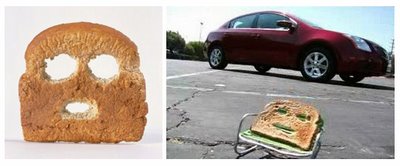 I wondered about this too: a newish ad by Nissan features a pseudo-hipster living in his Sentra for a week, and one scene features a familiar "face"--a piece of bread with a smiley face chewed into it, the spitting image of Matt Johnson's sculpture Breadface that graced the cover of the exhibition catalogue for the UCLA Hammer's Thing: New Sculpture from Los Angeles. Tyler Green writes: "I'd guess that Nissan's ad firm TBWA\Chiat\Day -- which, wouldn't ya know it, is based in Los Angeles -- was plenty familiar with Breadface, wouldn't you?"
I wondered about this too: a newish ad by Nissan features a pseudo-hipster living in his Sentra for a week, and one scene features a familiar "face"--a piece of bread with a smiley face chewed into it, the spitting image of Matt Johnson's sculpture Breadface that graced the cover of the exhibition catalogue for the UCLA Hammer's Thing: New Sculpture from Los Angeles. Tyler Green writes: "I'd guess that Nissan's ad firm TBWA\Chiat\Day -- which, wouldn't ya know it, is based in Los Angeles -- was plenty familiar with Breadface, wouldn't you?"Earlier in art rip-offs: Nike cops Robin Rhode's style, the Detroit Tigers copy Banksy, and Nike swipes Minor Threat album cover. The other way around: Minerva Cuevas riffs on Del Monte.
11.18.2006
Bush signed off on detainee protocols
According to the New York Times/International Herald Tribune, the CIA has admitted that two documents exist which directly link George W. Bush to protocols on interrogation and detention of terror suspects. While the content of these documents haven't been released, they include "a directive signed by President Bush granting the CIA the authority to set up detention facilities outside the United States and outlining interrogation methods that may be used against detainees" and a Justice Department legal analysis "specifying interrogation methods that the CIA may use against top Al Qaeda members." Only release of the documents will clear up whether Bush himself signed off on torture prohibited by the Geneva Conventions. "If President Bush and the Justice Department authorized the CIA to torture prisoners, the public has a right to know," says Jameel Jaffer of the ACLU.
Is Rove next?
Rumor has it that Karl Rove is headed for the door, according to The White House Bulletin.
The rumors that chief White House political architect Karl Rove will leave sometime next year are being bolstered with new insider reports that his partisan style is a hurdle to President Bush’s new push for bipartisanship. “Karl represents the old style and he’s got to go if the Democrats are going to believe Bush’s talk of getting along,” said a key Bush advisor.
11.16.2006
Inverse-pollution art.
 An excellent find by the ever intriguing PlaceboKatz:
An excellent find by the ever intriguing PlaceboKatz: Alexandre Orion is cleaning São Paulo’s tunnels by scraping the deposited vehicle exhaust soot from the walls to make hundreds of sculls. Even so police turned up several times they couldn´t do much as cleaning is no crime. After some time the São Paulo municipal started their own cleaning mission, consequently only cleaning the parts already cleaned by Alexandre. Again the skulls appeared on the remaining soot canvas and this time the city decided to clean all tunnels.
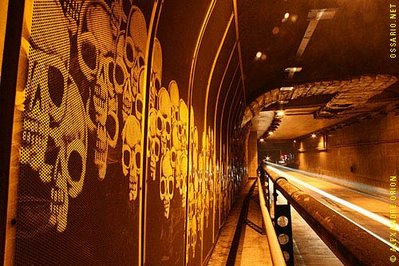

CNN to Ellison: Prove you're "not working with our enemies."
As the country's first Muslim member of Congress, Keith Ellison is racking up time with the national media. While WCCO reports that "two Jihadists Web sites linked to Al Qaeda made it clear that terrorists don't think much of Keith Ellison," CNN's Glenn Beck takes the opposite tack, telling the Minneapolis-area Congressman: "[W]hat I feel like saying is, 'Sir, prove to me that you are not working with our enemies.'"
Watch it:
11.15.2006
Confirming the obvious.
In case you missed this verification that Fox News is neither fair nor balanced, Huffington Post has published an internal Fox memo written by a news VP that alerts staffers to "be on the lookout for any statements from the Iraqi insurgents...thrilled at the prospect of a Dem controlled Dongress." Click on the image or go here to see the full-sized document.
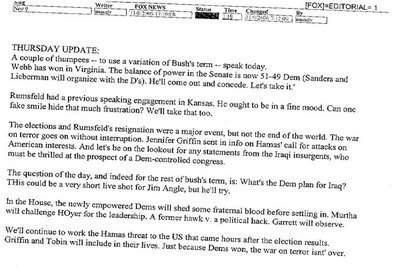

Book: By Hand
 From the meat dress mentioned here to the sock monkey dress here, I'm going to keep the craft theme alive with a look at the new book By Hand: The Use of Craft in Contemporary Art. In the catalogue for the UK Crafts Council's 2004 exhibition Boys Who Sew, curator Janice Jeffries defines the term " to craft":
From the meat dress mentioned here to the sock monkey dress here, I'm going to keep the craft theme alive with a look at the new book By Hand: The Use of Craft in Contemporary Art. In the catalogue for the UK Crafts Council's 2004 exhibition Boys Who Sew, curator Janice Jeffries defines the term " to craft":As a verb, though, "to craft" seemingly means to participate in some small-scale process. This implies several things. First, it affirms the results of involved work. This is not some kind of detached activity... To craft is to care... [It] implies working on a personal scale--acting locally in reaction to anonymous, globalized, industrial production...Artists that come to mind immediately are Robert Gober, who hand-makes replicas of everything from a kitchen sink to tissue boxes, and Kiki Smith, who's featured in By Hand. That book, inspired in party by Jeffries' definition, features innovative and unexpected uses of craft in contemporary art, accompanied by first-person statements by each artist. One such artist is Rob Conger whose art--latch-hook rugs like the ones he made as a youth--focuses frequently on the mediated dreams of money: he's done yarn homages to lottery lines, The Price is Right, and Alan Greenspan, to name a few. ("We confuse our desire for beauty with our desire for money," he writes.)
Rob Conger's The Big Wheel, woven acrylic thread on quarter-inch mesh, 1999
Rob Conger, Powerball Line, woven acrylic yarn on quarter-inch canvas mesh, 1998
Not unlike Kara Walker's transformation of the stately craft of black-paper silhouettes into shocking exposes on race and gender, Kent Hendricksen takes found tapestries and embroiders in ropes and hoods "turning light-hearted innocence into dark vignettes of sadism and emotional aggression."
Kent Henricksen, Lady Lovers (The Secret), embroidery thread on woven fabric mounted on wood, 2004Robyn Love, whose guerrilla knitting projects have included a gravestone cozy, created a Memorials project, in which she knit what she felt were missing elements of objects and structures like a bus shelter and World War I statue. "My cozies were intended to obscure the thing that was already obscuring the original person or event."
Memorial: The Doughboy (installed in Doughboy Plaza, Woodside, NY), knit wool, 1999[Cross-posted at Off-Center.]
Fruit Roll-Up Shirt
Artist, entrepeneur, and Minnesota Rollergirl Rebecca Yaker makes some curious clothing. Her portfolio includes an un-Prom dress made out of sock monkeys, an outfit "constructed out of toy foods (tomatoes, cheese slices, roast beef, white bread, bologna, hamburgers, and lettuce), clear vinyl, and plastic coated metal," and this sweet Fruit Roll-Up Western Shirt:
This shirt is constructed entirely out of various fruit roll-ups--strawberry, tropical fruit, and electric blue (not really a recognizable favor, but it's tasty)--finished with rhinestone snaps up the center placket. It was nearly impossible not to eat my supplies, but somehow I managed not to.
11.13.2006
Black Power Michelin Man
Image of the day: The Big One World by Bruno Peinado. W-M-M-N-A and PlaceboKatz have more on the artist.
11.12.2006
Feingold won't run.
Wisconsin's Russ Feingold, in my opinion the Senate's most honorable and progressive member, announced this morning that he won't be seeking the Democratic nomination for a 2008 presidential run. While I'm disappointed he won't be in the race, I'm glad he'll be part of a Senate that can make real change come January. He writes:
...Like many Americans, I am excited by the results of the November 7th election. My fourteen years in the Senate have been the greatest privilege of my life and I am extremely pleased with what we have accomplished. During so much of that time, however, we Democrats have not only been in the minority but have often been so deeply mired there that my role has often been to block bad ideas or to simply dissent. That is a very important role but I relish the thought that in this new Congress we can start, not only to undo much of the damage that one-party rule has done to America, we can actually advance progressive solutions to such major issues as guaranteed healthcare, dependence on oil, and our unbalanced trade policies.
11.10.2006
Russian Architecture
From English Russia, a collection of images featuring the eccentric and once modern architecture of the former Soviet Union:

.

.
11.09.2006
'07.
 Given the Democratic takeover of the House and Senate, Kyle at Bumperactive is slyly suggesting that maybe another Democratic takeover is in store his new bumpersticker. Will Pelosi and Co. investigate the Bush administration's intelligence in the runup to war? How about Jack Abrahamoff? Proceeds of bumpersticker sales go to the DNC.
Given the Democratic takeover of the House and Senate, Kyle at Bumperactive is slyly suggesting that maybe another Democratic takeover is in store his new bumpersticker. Will Pelosi and Co. investigate the Bush administration's intelligence in the runup to war? How about Jack Abrahamoff? Proceeds of bumpersticker sales go to the DNC.
11.08.2006
Ron Mueck at Brooklyn Museum
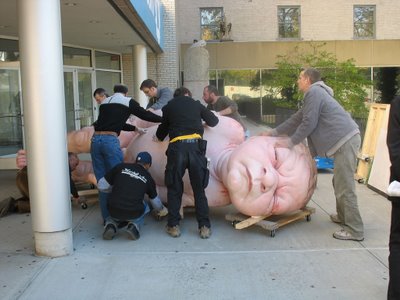 What looks like an art museum birthing a giant is really a Ron Mueck sculpture being loaded in for his just-opened show at the Brooklyn Museum. See the museum's Flickr page for more images of the exhibition. Via Modern Art Notes.
What looks like an art museum birthing a giant is really a Ron Mueck sculpture being loaded in for his just-opened show at the Brooklyn Museum. See the museum's Flickr page for more images of the exhibition. Via Modern Art Notes.
BREAKING: Rumsfeld resigning?
First Santorum and Mark Kennedy out, Keith Ellison and Tim Walz in, and now Rumsfeld resiging? Newsday, citing GOP sources, is reporting he's stepping down. How sweet it is... (Although Fox News has a weird item saying Rumsfeld has no such plans; the piece's headline says differently: "Donald Rumsfeld Resigning as Defense Secretary.")
Turns out Bush admitted lying when he said, just a few days ago, that Rumsfeld would stay on the job til the end of Bush's tenure. Oh well; we're accustomed to that by now.
Turns out Bush admitted lying when he said, just a few days ago, that Rumsfeld would stay on the job til the end of Bush's tenure. Oh well; we're accustomed to that by now.
11.07.2006
Do me a favor:

P.S. Hey Minnesotans, I'll be liveblogging the Secretary of State's race, and my colleagues at Minnesota Monitor will be covering other races. Drop by.
Thomas Allen's Book Art
Artist Thomas Allen cuts up old pulp fiction novels creating intriguing puns and unexpected narratives. For more on artists manipulating books, check out this Metafilter post.
11.06.2006
Jesse Jackson: "Tomorrow is Minnesota's big moment."
 On his way to a rally for Democrats on Minneapolis' East Lake Street tonight, civil rights leader Rev. Jesse Jackson made a stop in North Minneapolis at the home of State Sen. Linda Higgins. Although he was there to rally the assembled before tomorrow's mid-term election, he was among friends--Keith and Kim Ellison, State Senate candidate Augustine "Willie" Dominguez, Hennepin County Commissioner candidate Gregory Gray, former city council president Jackie Cherryhomes and her husband, defense attorney, Tyler Clayton, councilman Don Samuels and his wife Sondra, three dozen northside residents and their children (including one who got her copy of Green Eggs and Ham autographed by Jackson)--so he assumed a casual, at times quiet, tone that resembled his trademark fiery speeches only in his adept wordplay.
On his way to a rally for Democrats on Minneapolis' East Lake Street tonight, civil rights leader Rev. Jesse Jackson made a stop in North Minneapolis at the home of State Sen. Linda Higgins. Although he was there to rally the assembled before tomorrow's mid-term election, he was among friends--Keith and Kim Ellison, State Senate candidate Augustine "Willie" Dominguez, Hennepin County Commissioner candidate Gregory Gray, former city council president Jackie Cherryhomes and her husband, defense attorney, Tyler Clayton, councilman Don Samuels and his wife Sondra, three dozen northside residents and their children (including one who got her copy of Green Eggs and Ham autographed by Jackson)--so he assumed a casual, at times quiet, tone that resembled his trademark fiery speeches only in his adept wordplay. The real occasion was a sign-party: ever since Paul Wellstone's first campaign, Higgins has been organizing the placement of "Vote Today" signs--120 of them, purchased by Higgins--on the north and south sides of town. The crowd was truly diverse, a "rainbow coalition," as Dominguez said in his introduction of Jackson. Founder of the Rainbow/PUSH Coalition, Jackson, too, noted the racial mix of the audience:
The real occasion was a sign-party: ever since Paul Wellstone's first campaign, Higgins has been organizing the placement of "Vote Today" signs--120 of them, purchased by Higgins--on the north and south sides of town. The crowd was truly diverse, a "rainbow coalition," as Dominguez said in his introduction of Jackson. Founder of the Rainbow/PUSH Coalition, Jackson, too, noted the racial mix of the audience:An African American can reconcile Davey Crockett in Appalachia and Elvis Presley’s people in Memphis, the Grand Ole Opry in Nashville and Stax Records and Isaac Hayes in Memphis: you’re doing some coalition building. And it speaks well for the future of who we are. What makes this race tomorrow make me tremble—why I had to come to be with Keith tonight once again—there are these breakthrough moments. We wish we were around the Boston Tea Party, one of those bigs moments. Wished we’d been someplace around when the 13th Amendment was passed into law—by two votes, I must add—in 1865. To have been someplace around Kansas in 1954 when legal Jim Crow was determined to be outlawed. To have been at the march on Washington in 1963. These are big moments. Tomorrow in Minnesota’s a big moment. After Hubert Humphrey in the ’48 speech and Paul Wellstone comes Keith, an African American Muslim in a non-majority black district: This is America at its best. This is the dream team.
 Along with optimism came criticism: Jackson had tough words for the Republican Party. On the Iraq, "a war that has no sense of higher purpose and no moral foundation," he said, "Bin Laden hit us, Saddam didn’t, and we’ve given up on pursuing the man who hit us. It’s like going to the dentist and pulling the wrong tooth." He decried the cutting of $12 billion in Pell Grants, while--according to a student he met at the University of Minnesota today--tuition has gone up 83 percent. And he mentioned how the "October Surprise," Saddam Hussein's death sentence announced within days of the election, was foiled by the misdeeds of Bush spiritual adviser Ted Haggard. On why Democrats shouldn't exploit Haggard's downfall, he said, "The lesson to be learned about hypocrisy [is] when you have a religion devoid of forgiveness and tolerance that when your crisis comes you can’t find the mercy and tolerance, because you haven’t given it out."
Along with optimism came criticism: Jackson had tough words for the Republican Party. On the Iraq, "a war that has no sense of higher purpose and no moral foundation," he said, "Bin Laden hit us, Saddam didn’t, and we’ve given up on pursuing the man who hit us. It’s like going to the dentist and pulling the wrong tooth." He decried the cutting of $12 billion in Pell Grants, while--according to a student he met at the University of Minnesota today--tuition has gone up 83 percent. And he mentioned how the "October Surprise," Saddam Hussein's death sentence announced within days of the election, was foiled by the misdeeds of Bush spiritual adviser Ted Haggard. On why Democrats shouldn't exploit Haggard's downfall, he said, "The lesson to be learned about hypocrisy [is] when you have a religion devoid of forgiveness and tolerance that when your crisis comes you can’t find the mercy and tolerance, because you haven’t given it out."The evening was short and the excited crowd seemed weary--talk of naps and looking forward to "when it's over" could be overheard--but an excitement was also palpable. And Jackson hit on it: "There’s electricity in the air as I travel around the country. There is a fresh wind blowing, taking on the kind of foulness that’s in the air... I guess I’ve been in the dark so long, a little light will do me—just a little breeze—will give me life."








